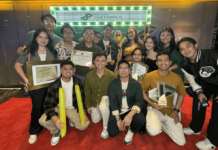After making a name for himself for his highly detailed pen-and-ink drawings, College of Fine Arts and Design alumnus Janos Delacruz has turned to painting. His exhibit, Kalamay, which ran at the Cultural Center of the Philippines (CCP) April 3 to May 11, consisted of 15 oil-on-canvas works governed by his artistic approach of presenting social truths concealed in playful images. Delacruz explained that the variant meanings of “kalamay” inspired the works. The word means sweetness in Visayan. But in Tagalog, “lamay” means to grieve.
In “Happy Meal Nation,” Delacruz critiqued Filipinos' penchant for fast food and likening it to religious devotion, like the novena they make every Wednesday to Our Lady of Perpetual Help.
The triptych, “Hapunan Kina Juan,” illustrated the divide between the Filipino social classes. The first image showed starving dogs representing the poor while the third image featured various chess characters symbolizing the manipulative nature of the rich. In between was the second panel, showing a God-like image perhaps to balance two classes.
Meanwhile, works by other Thomasian artists were presented in Unang Agos, which mounted paintings and installation works exploring the Philippines' rich marine resources. The exhibit is in view at the Pasilyo Vicente Manansala of the CCP until June 23.
Serj Bumatay, a magna cum laude from the College of Fine Arts and Design, created a series of paintings whose frames resembled boat windows. Earth tones such as beige, brown, and light blue were the dominant color palettes of the paintings.
College of Commerce and Business Administration alumnus Zeus Bascon’s “Promises ii” made use of beads, pearls and other materials usually found in religious items to create a large, dazzling fishing net.
Meanwhile, Mica Cabildo’s “Cabo Negro” is a graphic play on the construction of a balanghay, an ancient Philippine plank boat. The installation piece features bundles of ropes and rope light hanging on crossed wooden planks, while a geometric mural serves as backdrop.
"Titled Cabo Negro because of the sturdy indigenous rope used to sew together planks of wood to make the balanghay. And I thought it was fitting because of the light component," she said.
This is the first exhibit sponsored by the Outlooke Pointe Foundation, which promotes Filipino patriotism through art and cultural initiatives. Elyssa Christine A. Lopez, Ethan James M. Siat and Bianca Kristin A. Taray













